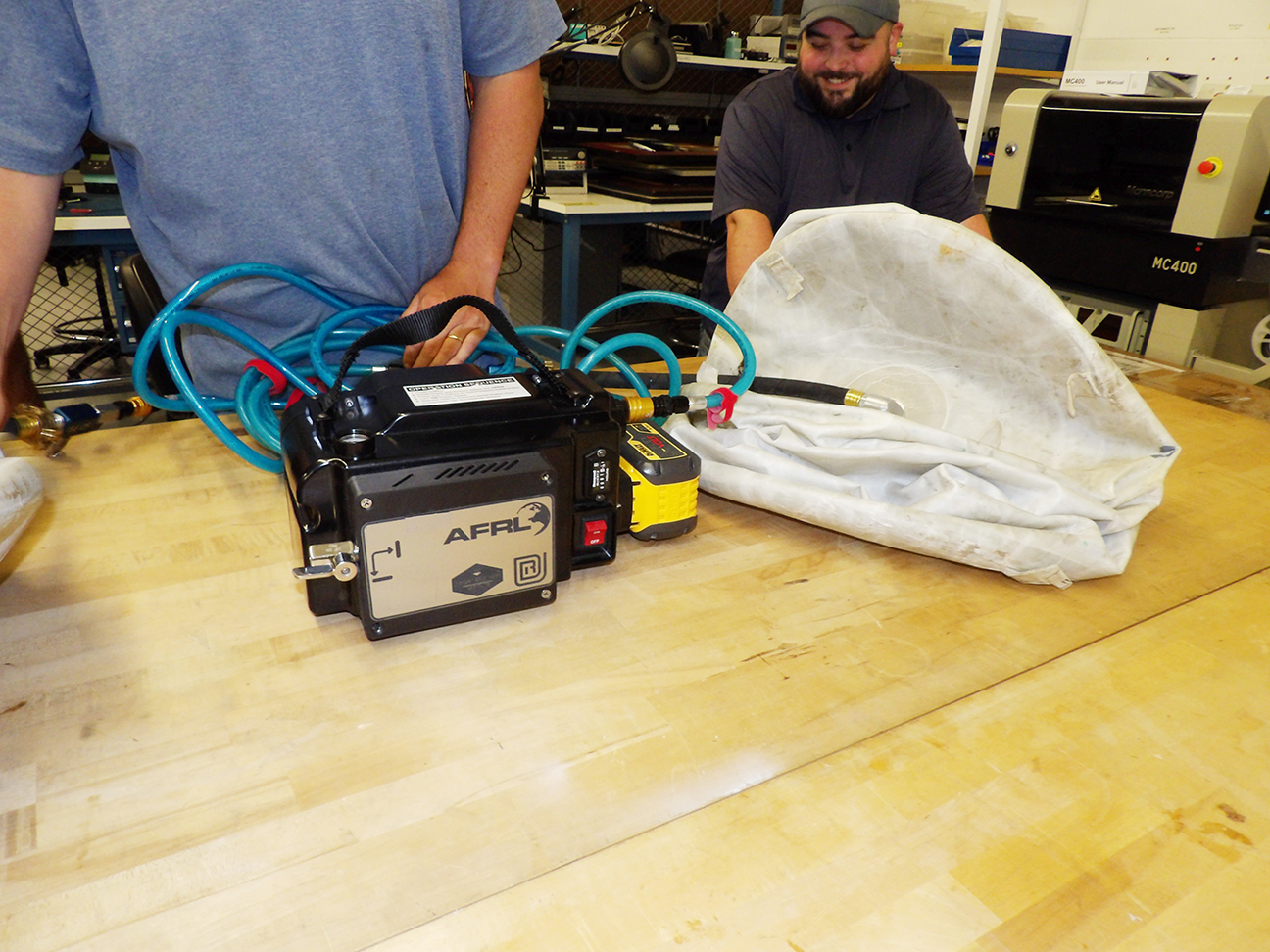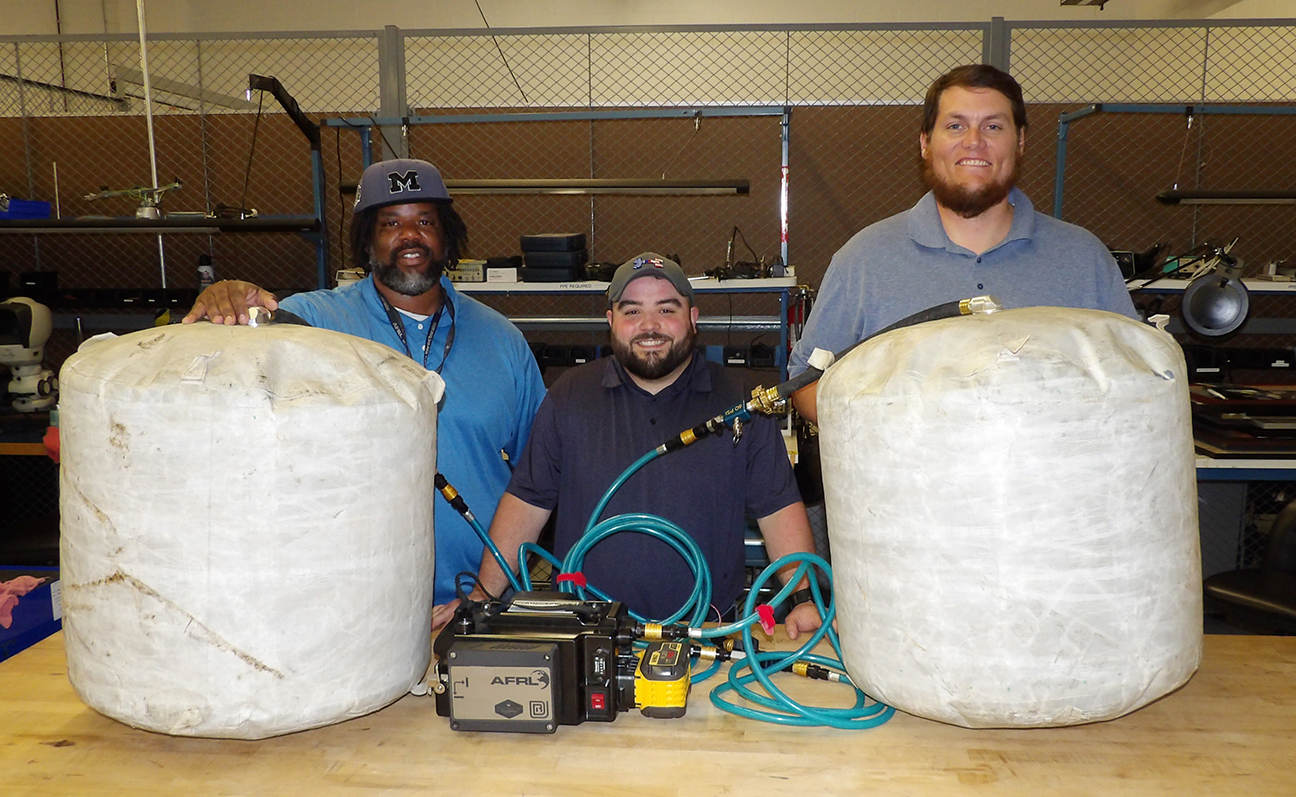WRIGHT- PATTERSON AIR FORCE BASE, Ohio (AFRL) — An Air Force Research Laboratory, or AFRL, Center for Rapid Innovation, or CRI, concept to help military first responders lift heavy objects and quickly exit contested environments went from idea to field testing in about four months.
Previously, rescue workers used the kits’ two air-filled bags to lift 45,000 pounds. But the bags took more than 10 minutes to deflate, exposing personnel to other risks in dynamic environments and delaying extraction.
In November 2023, Air Force Special Operations Command, or AFSOC, presented CRI with the technical challenge to reduce the deflation time.

From left: Wright Brothers Institute Computer and Electronics Engineer Claud Nichol, University of Dayton Research Institute Mechanical Engineer Jason Adams and Air Force Research Laboratory Center for Rapid Innovation Mechanical Engineer John “J.D.” Bales, stand with a heavy lift kit, or HLK, which they modified to allow the bags to be deflated more quickly in dangerous environments at the Wright Brothers Institute Proving Ground Facility on May 21, 2024. The Heavy Lift Kit can be used by first responders to lift objects weighing as much as 45,000 pounds using two inflatable bags. (U.S. Air Force photo / Patrick Foose)
“AFSOC users were exposed to hazardous and contested environments,” CRI AFSOC Portfolio Lead Dr. Thomas G. Howell said. “At the Wright Brothers Institute’s Proving Ground Facility, the team was able to create a solution that would deflate the bags in approximately one minute.”
Howell said the team — comprised of CRI Mechanical Engineer John “J.D.” Bales, University of Dayton Research Institute Mechanical Engineer Jason Adams and Wright Brothers Institute Computer and Electronics Engineer Claude Nicol — implemented a solution that integrated a Venturi pump into the overall system to take advantage of the air compressor that inflates the bags.

University of Dayton Research Institute Mechanical Engineer Jason Adams works on the Heavy Lift Kit, or HLK, which is a solution that the Air Force Research Laboratory Center for Rapid Innovation devised to allow the bags to be quickly deflated in contested environments at the Wright Brothers Institute Proving Ground Facility on May 21, 2024. Rescue workers can use the pairs of HLK inflatable bags to lift as much as 45,000 pounds. (Air Force photo / Patrick Foose)
Bales said the off-the-shelf pump was key to ensure sustainability of the solution in the future.
“Bespoke solutions are hard to remanufacture, and we want to make sure this problem stays solved,” Bales said.
CRI created the original Heavy Lift Kit, or HLK, in 2019. Bales said the process of developing the quick-deflating modification started with input from end users.
“Once we had a good understanding of the challenges proposed, we investigated the users’ idea to use the compressor itself to somehow deflate the bags,” Bales said. “This was the best approach, as it would not require any extra gear to be carried into the field — always a big benefit.”
Bales’ team used two kits from the original development to create the solution.
“We dove immediately into taking one apart to see how the compressor functioned [to determine] whether it could be used to drain the bags,” Bales said. “After three prototypes, we hit on the right combination of commercial and in-house designed parts and did some testing at our prototyping lab, the Wright Brothers Institute’s Proving Ground Facility.”
The new prototype was delivered to the customer for field testing in March.
“Everything has been working great since then, and we are trying to set up a modification and sustainment plan to modify all the HLKs the customer owns and make sure they can be serviced in the future,” Bales said.

From left: Wright Brothers Institute Computer and Electronics Engineer Claud Nichol, University of Dayton Research Institute Mechanical Engineer Jason Adams and Air Force Research Laboratory Center for Rapid Innovation Mechanical Engineer John “J.D.” Bales, stand with a heavy lift kit, or HLK, which they modified to allow the bags to be deflated more quickly in dangerous environments at the Wright Brothers Institute Proving Ground Facility on May 21, 2024. The Heavy Lift Kit can be used by first responders to lift objects weighing as much as 45,000 pounds using two inflatable bags. (U.S. Air Force photo / Patrick Foose)
Bales said the Wright Brothers Institute’s Proving Ground Facility at 105 Janney Road in Dayton is vital to the CRI’s work.
“Aside from being the place where we did every aspect of this effort from conceptualization to test, it also serves an essential role for numerous other existing CRI efforts and gives us the internal capability to explore concepts before and after the workshops we hold regularly to explore users’ problems,” Bales said.
Howell said AFSOC has acquired new HLKs to support their teams.
“By utilizing our prototyping facility, we were able to quickly address a customer need and provide them a critical capability they needed,” Howell said. “Our customers will be exposed to the hazardous environments they are in for a shorter of period of time now, due to this modification.”
ABOUT AIR FORCE RESEARCH LABORATORY
The Air Force Research Laboratory is the primary scientific research and development center for the Department of the Air Force. AFRL plays an integral role in leading the discovery, development, and integration of affordable warfighting technologies for our air, space and cyberspace force. With a workforce of more than 12,500 across nine technology areas and 40 other operations across the globe, AFRL provides a diverse portfolio of science and technology ranging from fundamental to advanced research and technology development. For more information, visit: www.afresearchlab.com.
ABOUT THE CENTER FOR RAPID INNOVATION
The Center for Rapid Innovation is aligned with the Air Force Research Laboratory Integrated Capabilities Directorate with a mission to rapidly mature technologies to deliver solutions to urgent warfighter needs in two years or less.
ABOUT THE INTEGRATED CAPABILITIES DIRECTORATE
The mission of the Integrated Capabilities Directorate, or AFRL/RS, is to accelerate the Department of the Air Force’s future force through cross-discipline collaboration. The directorate seeks to be the DAF’s leading source of operationally relevant future force solutions. It has four component offices – Architecture and Systems Engineering, or ASE; the Center for Rapid Innovation, or CRI; Strategic Development Planning and Experimentation, or SDPE; and the Transformational Capabilities Office, or TCO.
